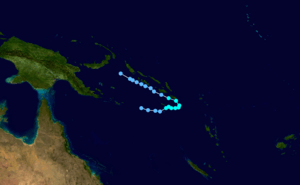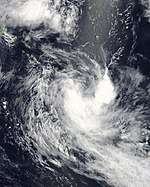2018–19 South Pacific cyclone season
| 2018–19 South Pacific cyclone season | |
|---|---|
 Season summary map | |
| Seasonal boundaries | |
| First system formed | September 26, 2018 |
| Last system dissipated | Season Ongoing |
| Strongest storm | |
| Name | Liua |
| • Maximum winds |
75 km/h (45 mph) (10-minute sustained) |
| • Lowest pressure | 994 hPa (mbar) |
| Seasonal statistics | |
| Total disturbances | 1 |
| Total depressions | 1 |
| Tropical cyclones | 1 |
| Total fatalities | None |
| Total damage | None |
| Related articles | |
The 2018–19 South Pacific cyclone season is the period of the year when most tropical cyclones form within the South Pacific Ocean to the east of 160°E. The season officially runs from November 1, 2018 to April 30, 2019, however a tropical cyclone could form at any time between July 1, 2018 and June 30, 2019 and would count towards the season total. During the season, tropical cyclones will be officially monitored by the Regional Specialized Meteorological Center (RSMC) in Nadi, Fiji and the Tropical Cyclone Warning Centers in Brisbane, Australia and Wellington, New Zealand. The United States Armed Forces through the Joint Typhoon Warning Center (JTWC) will also monitor the basin and issue unofficial warnings for American interests. RSMC Nadi attaches a number and an F suffix to tropical disturbances that form in or move into the basin while the JTWC designates significant tropical cyclones with a number and a P suffix. RSMC Nadi, TCWC Wellington and TCWC Brisbane all use the Australian Tropical Cyclone Intensity Scale and estimate windspeeds over a period of ten minutes, while the JTWC estimated sustained winds over a 1-minute period, which are subsequently compared to the Saffir–Simpson hurricane wind scale (SSHWS).
Seasonal forecasts
| Source/Record | Tropical Cyclone |
Severe Tropical Cyclone |
Ref |
|---|---|---|---|
| Record high: | 1997–98: 16 | 1982–83: 10 | [1] |
| Record low: | 2011–12: 3 | 2008–09: 0 | [1] |
| Average (1969-70 - 2017-18): | 7.1 | — | |
| NIWA October | 7-11 | 4 | [2] |
| Region | Chance of above average |
Average number |
Actual activity |
| Western South Pacific | 53% | 7 | 1 |
| Eastern South Pacific | 43% | 4 | 0 |
| Source:BOM's South Pacific Tropical Cyclone Season Outlook.[3] | |||
Seasonal summary

Systems
Tropical Cyclone Liua
| Category 1 tropical cyclone (Australian scale) | |
| Tropical storm (SSHWS) | |
  | |
| Duration | September 26 (Entered basin) – September 28 (Exited basin) |
|---|---|
| Peak intensity | 75 km/h (45 mph) (10-min) 994 hPa (mbar) |
A disturbance which initially formed in the Australian region basin crossed into the South Pacific basin on September 26 and strengthened, and was designated as Tropical Depression 01F by RSMC Nadi.[4] Late on September 26, the storm intensified into a tropical cyclone, and was given the name Liua. Liua is the earliest-forming named tropical cyclone in the South Pacific basin since reliable records began, surpassing 1997's Cyclone Lusi.[5]
Storm names
Within the Southern Pacific a tropical depression is judged to have reached tropical cyclone intensity should it reach winds of 65 km/h, (40 mph) and it is evident that gales are occurring at least halfway around the center. With tropical depressions intensifying into a tropical cyclone between the Equator and 25°S and between 160°E - 120°W named by the FMS. However should a tropical depression intensify to the south of 25°S between 160°E and 120°W it will be named by MetService in conjunction with the FMS. Should a tropical cyclone move into the basin from the Australian region it will retain its original name. The next 10 names on the naming list are listed here below.[6]
|
|
Season effects
This table lists all the storms that developed in the South Pacific to the east of longitude 160°E during the 2018–19 season. It includes their intensity on the Australian tropical cyclone intensity scale, duration, name, landfalls, deaths, and damages. All data is taken from the FMS and/or MetService, and all of the damage figures are in 2018 USD.
| Name | Dates active | Peak classification | Sustained wind speeds |
Pressure | Areas affected | Damage (USD) |
Deaths | Refs |
|---|---|---|---|---|---|---|---|---|
| Liua | September 26 – 28 | Tropical cyclone | 75 km/h (45 mph) | 994 hPa (29.35 inHg) | Solomon Islands | Unknown | Unknown | |
| Season aggregates | ||||||||
| 1 system | September 26 – Present | 75 km/h (45 mph) | 994 hPa (29.35 inHg) | |||||
See also
- Tropical cyclones in 2018
- List of Southern Hemisphere cyclone seasons
- Atlantic hurricane seasons: 2018, 2019
- Pacific hurricane seasons: 2018, 2019
- Pacific typhoon seasons: 2018, 2019
- North Indian Ocean cyclone seasons: 2018, 2019
- 2018–19 South–West Indian Ocean cyclone season
- 2018–19 Australian region cyclone season
References
- 1 2 Climate Services Division (October 26, 2010). Tropical Cyclone Guidance for Season 2010/11 for the Fiji and the Southwest Pacific (PDF) (Report). Fiji Meteorological Service. Archived from the original (PDF) on February 27, 2012. Retrieved October 17, 2016.
- ↑ "Southwest Pacific Tropical Cyclone Outlook - October 2018". National Institute of Water and Atmospheric Research. October 11, 2018. Archived from the original on October 11, 2018. Retrieved October 11, 2018.
- ↑ National Climate Centre (October 9, 2017). "South Pacific Tropical Cyclone Outlook for 2017 to 2018". Australian Bureau of Meteorology. Archived from the original on 2017-10-11. Retrieved October 11, 2017.
- ↑ "Tropical Disturbance Advisory Number A1". RSMC Nadi. 2018-09-26. Archived from the original on 2018-09-26. Retrieved 2018-09-26.
- ↑ "Liua becomes earliest tropical cyclone on record to form in the South Pacific Ocean". Accuweather.com. Retrieved 28 September 2018.
- ↑ RA V Tropical Cyclone Committee (October 11, 2018). Tropical Cyclone Operational Plan for the South-East Indian Ocean and the Southern Pacific Ocean 2018 (PDF) (Report). World Meteorological Organization. pp. I–4 , – II–9 (9–21). Archived from the original on October 12, 2018. Retrieved October 12, 2018.
External links
| Wikimedia Commons has media related to 2018-19 South Pacific cyclone season. |
- World Meteorological Organization
- Australian Bureau of Meteorology
- Fiji Meteorological Service
- New Zealand MetService
- Joint Typhoon Warning Center